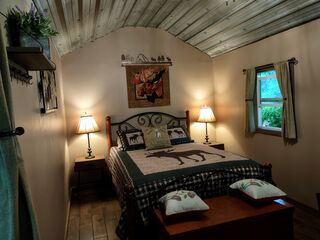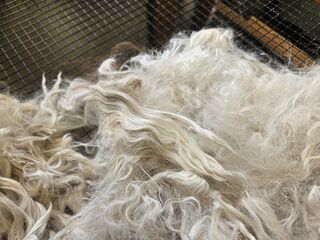About Us
Our Ranch is located in beautiful North Eastern Washington about an hour northwest of Spokane off state Highway 231. We are slightly off the beaten path, but not so far that it makes visiting year-round difficult. Highway 231 makes a nice drive for those coming from out of the area. The Leisure Ranch is over 200 peaceful acres with abundant wildlife; Deer, Elk, Moose and Turkeys. We are surrounded by thousands of acres of private timber land which is open to hiking, biking and horseback riding, but not motor vehicles. Seven excellent fish filled lakes are located within a 30-minute drive. Tucked into our small valley is our Alpaca facility.
The Leisure Ranch is the result of what happens when two people who both had stressful careers decide to leave the rat race and embark on a journey to a simpler and sustainable lifestyle. We started with a clean slate. The property was part of a much larger parcel that was used for years in dry lot hay operation. Other than a rather dilapidated hay barn and an old shop, we had no real infrastructure when we started. This allowed us to plan the layout of the ranch and purpose build our barns and pasture layout. Our main goal in setting up the ranch was to do it in a way that one person could tend to most of the chores associated with the ranch. Realizing that neither of us is getting any younger, we did not wish to create unnecessary work for ourselves! We designed the place with two completely separate barns. We have heard several stories about males “accidentally” getting in with the females. We wanted to take steps to prevent this from happening. We have the male and female barns a distance apart from each other. A six-foot perimeter fence separates them as well.
The larger barn houses the females in three large pens. One of which can be sectioned off so as to quarantine new animals, wean youngsters etc. This barn also contains our scale, work bench/desk bins for pellets, beat pulp and room for a week’s worth of hay bales. We also have a seating area to allow comfortable viewing of the animals. The male barn is smaller with one large pen and room for a weeks’ worth of hay bales. Both are set up with fans to circulate the air on those hot summer days. We believe in keeping the floors dirt except where we have the scale and seating area. This allows natural drainage of urine. For all but three months out of the year alpacas generally poo and pee outside. Except in the winter.
We did run water and power lines for the future addition of another barn. We also have water line run alongside our perimeter fence for future expansion.
Currently, about ten acres are fenced and cross fenced. With large predators such as mountain lions, coyotes, wolves and bears lurking nearby, we use 6-foot no-climb fence on the perimeter with four inch eight-foot-tall posts. Six-inch eight-foot posts set in cement are used to set up stretch panels and corners. Four-foot farm fence with T- posts are used for the cross fencing. We have not had any problems.
About four acres are set aside for our males in two and a half acre pastures, the rest is set up in one-acre pastures with a central ten-foot corridor with water hydrants by each gate. The male facility is connected as well. This allows us to rotate pastures or move any animal to any pasture we want by simply opening and closing gates and allowing the alpacas to come and go as they please. Or to “herd” them down a corridor. We did allow for a large tractor/UTV turn around at the end of the corridor. Most of the year the alpacas choose to spend both day and night outside, coming into the barn for water, when they think they will get some pellets, or to get out of the sun on very hot days. In the winter they rarely leave the barn. Eventually, 30 acres will be fenced and we will have a total of 15 one-acre pastures prepared for use by our growing heard.
In addition to the Alpacas, we have horses, miniature horses, some goats and chickens too!
The manure the animals provide is all used on the ranch. We generally have a “summer blend”, which is mostly straight alpaca poo, and a “winter blend” which has a lot of straw bedding in it as well. We keep the horse piles separate from the alpaca poo, and primarily spread it out on some of our pastures once it has thoroughly composted. This often takes a couple seasons, even turning the piles often. Frequently we have people ask us about sales and do sell it by the truck full only at this time.
The chickens spend a few hours most days turning and pecking at the poo piles. They also make the rounds in the barns. We have found that they do an excellent job keeping the fly population down.
The goats are allowed to graze in a pasture after the alpacas have been moved to the next one. We find that they will eat weeds that the alpacas don’t and the alpacas eat weeds the goats don’t. Grazing them after the alpacas, then letting the pasture rest for several months has worked out well for us. The chickens often find their way out to some of the pastures and work over the various poo piles. We do collect piles in the pastures once every few days. Towards the end of the season I often run a drag around each pasture to spread out any remaining poo piles before the snow comes.
Once we have all 15 pastures online, we plane to designate one each year as the poo pasture and deposit all the alpaca poo there. By the end of the season we will spread them out and then lightly disc the pasture. We hope that this will condition our rather sandy soil over time.
We have a large vegetable garden and both some mature and young apple trees in our orchard and are developing a berry growing farm, but not on a huge industrial scale. The alpaca compost has really improved the soil in our gardens. Composting it by turning frequently and mixing in some brown and green matter helps make a good planning mix. Our “winter blend” has been excellent at this.
This last year we have had a new roof put on our shop along with an upgraded electrical panel. A lean to was added that is well insulated and climate controlled. We also had an old bathroom in the shop gutted, remodeled, connected to the existing septic and a door installed to the outside. The ranch now has its own clean bathroom close to the barns.
At the Leisure Ranch, our business plan calls for utilizing every aspect of the land as well as the alpacas on our ranch.
• Carefully consider the impact of any new ventures on land and wildlife living on the ranch.
• Developing further income generating businesses utilizing our beautiful location and the rich recreational assets available nearby (more on this to come soon!).
• Making educated breeding decisions using histograms and S.H.I.P. program data to improve our herd quality and Suri’s in general.
• Attending educational seminars at least once a year, to continue to expand our knowledge.
• Participate in alpaca shows when time and schedules allow.
• Maintain sales and stock levels suitable to the size of our facilities.
• Harvesting the fleece, for use in various marketable products.
• Utilizing the manure on site by composting as well as sales.
• Animals that are not up to breeding standards we be sold as “Fiber Only”
It has been a pleasure and an adventure developing the Leisure Ranch into a working Alpaca farm., It has been very rewarding to just be home, work the land and watch the place grow. So many of the people we have met at shows and seminars have been supportive and friendly. Indeed, we have made many great friends. We are proud to be a part of the alpaca community and want to share what we have learned with others who are interested.
We welcome guests to our Ranch and Tours are available by appointment. We enjoy talking with and introducing people to these special animals. So, give us a call or send us an email and come see the Leisure Ranch!
Thursday, May 12, 2022


